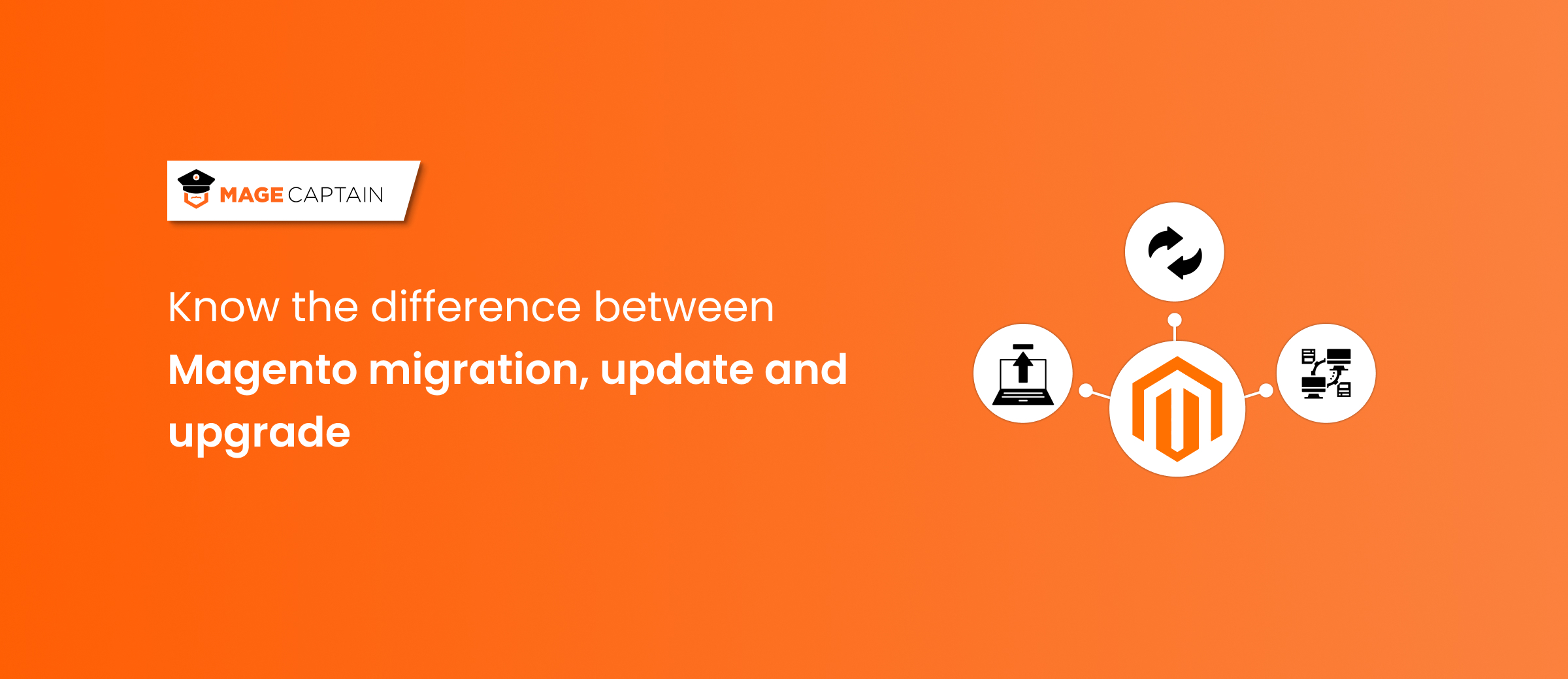We use cookies to make your experience better. To comply with the new e-Privacy directive, we need to ask for your consent to set the cookies. Learn more.
What Are the Differences Between Magento Migration, Update, and Upgrade?

In e-commerce, it is necessary to know about Magento migration, updates, upgrades, etc. These three processes look similar, yet they aren't. Adobe has stopped supporting Magento 1, ending its 12 years of journey. Many merchants have moved to new and improved Magento 2; more than 65,000 live websites are still using Magento 1.9, according to statistics by BuiltWith.
Reduction in performance, high costs of custom development, security vulnerabilities, usage of legacy software that can lead to PCI compliance issues, retailers suffering from legal ramifications, and huge fines are the major issues for Migration From Magento 1 to 2.
Let's look at the differences between migration, update, and Magento upgrade separately.
What is Magento migration?
The process of relocating an ecommerce store from Magento 1 to Magento 2 from another platform or CMS to Magento is Magento migration. It is a delicate process that requires a significant amount of time and effort to complete the entire process successfully. Magento migration usually consists of four primary steps: Store audit, Store development, data mapping and migration, and post-migration testing.
Store audit
Conducting a detailed store audit helps to recognize store data functions and customs before the start of the migration process. The new website configures, recreates, and improves the existing site function without data loss.
Store development
Developing the store on a new server to recreate the design and functions on Magento 1 store by using Magento 2 compatible themes, extensions, and custom codes is the next step for migration. The step includes configuring the right hosting environment for the Magento 2 Application to ensure it has hardware and software that perform optimally.
Data mapping and migration
Data mapping and migration is done to check whether the entire migration process went well. Adobe has developed a Magento data migration tool to help developers map and migrate database attributes for the existing Magento stores and Magento 2 to be installed.
Post-migration testing
Testing the new store to ensure all data is migrated successfully; post-migration testing has been carried out. This includes testing the business throughout the user experience to uncover problems caused by poorly mapped data properties.
Why migrate from magento 1 to magento 2?
The primary reason to migrate to Magento 2 is to improve performance and scalability. Moreover, the support for Magento 1 officially ended in 2020. It improves the shopping experience, SEO, and security features. Increase in Magento site speed.
The extension updates are easy, with a better customer experience and user-friendly checkouts. The admin panel is improved, and designs are kept mobile-oriented with responsive designs. It has a modern technology stack and the best testing capabilities.
How to migrate from Magento 1 to Magento 2?
There are ultimate seven steps for migration from Magento 1 to Magento 2
Step: 1- Set up Magento 2 store
Step: 2- Back up your source store data.
Step: 3- Magento 2 data migration.
Step: 4- Magento 2 extension migration and custom code.
Step: 5- Magento 2 theme migration.
Step: 6- Run recent data migration.
Step: 7- Change DNS and switch domain.
Benefits of migrating from Magento 1 to Magento 2
Smooth store migration
Magento 2 has most-feature rich and user-friendly admin panel that will catch your eye during migrating from Magento 2 to Magento 1. You can streamline the product creation workflow in Magento 2. You can create simple and configurable products, upload bulk images, and set prices and attributes such as product weight in Magento 2 rather than Magento 1.
Easily modified
Magento 2 features a modular architecture that helps developers to extend core functions instead of replacing them and makes the development process easy along with protecting the integrity of code. Magento 2 is built with design, patterns, and extensibility, allowing its extensions to be self-contained, reducing external dependencies and conflicts.
Robust integrations
Magento 1 API platform was built into the platform retroactively, which caused code duplication and differences between API and its core functions. However, Magento 2 supports major API technologies such as SOAP, REST, File Exchange, and GraphlQL natively, which makes it capable of integrating with third-party apps and services. Magento integrates with everything, whether it's an inventory management system, POS system, or third-party services.

What is the update?
An update in Magento is described as adding new functions or features to make it suitable for other stores. The patch version usually implements in the software. It can also be said that an update is a revision to make the software even better. Patch implementation may include error correction or the addition of new features. The update doesn't transfer your store from one version to another.
Why update your Magento store?
Magento store, when updated, adds new features regularly. The platform security is enhanced and improved. The store, when updated, performs better, and the process gets streamlined. A solo developer with sufficient technical expertise can complete store updating.
Benefits of updating the Magento store
Security
Magento updates improve security by fixing the latest patches in your system. Patches help to fix major bugs and solve security issues in your system. Magento 2.4.7 has 40 security enhancement that helps to close remote code execution (RCE) and cross-site scripting errors (XSS). If you update your store to the latest version of Magento, your online store becomes vulnerable and prevents it from security attacks.
Performance
When the platform code is improved, Magento 2 version delivers high performance by optimizing the website's speed and modifying the page format. The faster the page load time, the good set of changes in the section.
Code Enhancement
Every Magento version shows improvements in its new features. The latest Magento version includes ten functional fixes to core codes. Magento improvements have made generated codes easier to understand. A simpler code improves execution performance. As a result, the page loads faster.
What is a Magento upgrade?
When a Magento store moves a step ahead, suppose from Magento 2.2 to 2.4 is a Magento upgrade. Magento provides upgrades for improved functionality and features. You can also upgrade from Magento open source to Magento commerce. It includes modules, themes, language package updates, etc.
Reasons to upgrade to Magento
Whenever a Magento store upgrades, it adds more value, features, and functions. It improves the customer experience, which brings more conversion and sales. Whenever the store owner wishes, they can customize the store easily. It comes with a better admin interface that makes store operations easy. The integrations are powerful that make the checkouts streamlined. The code quality improves, and the site becomes mobile-friendly.
Benefits of Magento upgrades
New features
Magento developers are constantly developing and adding new features to the platform to offer its users the tools they need to run a successful e-commerce business. It is the only platform that brings the power of AI and ML into ecommerce at no extra cost. Magento Commerce provides product recommendation that provides users access to Adobe's proprietary AI-based technology, Adobe sensei, which allows merchants to offer personalized references to their customers with real-time data.
Better performance
Adobe tries to improve the functionality of the platform and its overall performance with every upgrade. The latest upgrade of Magento consists of code enhancements that improve the performance of Magento API, and the admin time for stores increases for large catalogs. Because of these modifications, Magento stores running version 2.4.2 may now support catalogs that are 20 times larger than in prior versions.
Upgrading infrastructure
Magento Upgrades the core changes, like the framework's core quality, by making the store infrastructure faster. The website becomes more resistant to high loads. The functional areas such as customer account, framework and database, sales, tax, and videos are aimed to be improved. The core infrastructure improves the framework's quality and the website's health.
Conclusion
Magento has a huge impact on the ecommerce world. It is capable of powering businesses of all sizes; hence, if you decide to upgrade, update or migrate your store to Magento 2, it will surely help to improve sales and boost business. If you still want to know more about Magento migration, upgrade and update, contact our expert from MageCaptain or click on the Contact us available on the website.
MageCaptain is a certified Adobe partner offering end-to-end Magento services, whether its Magento migration, update, upgrade, adding Magento extension, and more such services done by powerful Magento developers.



